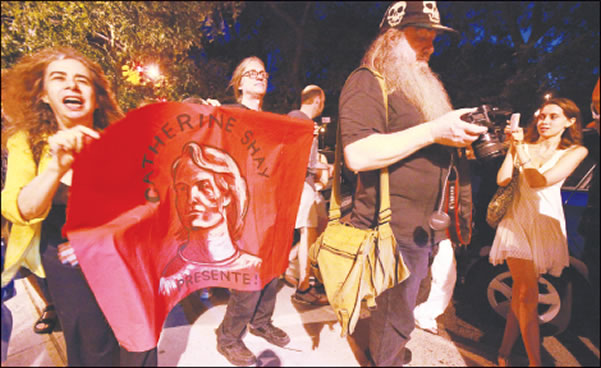By Jefferson Siegel
Last Saturday night a poignant memorial for an East Village activist turned into a traffic-stopping protest reminiscent of the neighborhood’s more turbulent history.
Paul and Monica Shay, longtime residents of E. 10th St., were each shot in the head, along with three others, a week earlier by a former associate of Paul’s while at their Pennsylvania home.
Monica, 58, lingered until Thursday, when she succumbed to her wounds. Her husband, Paul, 64, remains in critical condition. The Shays’ nephew, Joseph, and his girlfriend’s 2-year-old son, Gregory Erdmann, were also killed. The child’s mother, Kathryn Erdmann, is in critical condition.
“The best and worst of the Lower East Side, like all of us,” Stanley Cohen, an East Village activist lawyer, declared of the Shays at Saturday’s memorial.
“They were like old racehorses — they heard the bell and came out and ran,” he said of the Shays, who were well known in the East Village for their advocacy on behalf of the less fortunate.
Among their many deeds, the couple aided the homeless living in Tompkins Square Park’s “Tent City” in the 1980s. Paul, a plumber, would install and clear out the pipes in many of the East Village’s squats.
Monica adopted the “nom de guerre” of Catherine to distinguish between her activist life and her profession. For the past 11 years she was program director of the Arts and Cultural Management program at the Pratt Institute School for Art and Design on W. 14th St.
As colleagues gathered in the twilight and waited their turn to stand on a milk crate and recall their friend and colleague, a younger visitor stood quietly, lost in her own memories.
“Monica was wonderful,” said Kadrena Cunningham, a 2007 graduate of Pratt’s Arts and Culture program. “She cared about her students and their careers. All of the wonderful skills and insights she had, she imparted to us.”
Karl Rosenstein, left, and John Penley stopped northbound traffic on Avenue A, chanting, “Tompkins Square Everywhere!”
Most of the faces in the crowd were lined with experience. Friends who manned the barricades with Monica/Catherine over the decades spoke with one voice.
The Shays “gave us a lot of strength,” said artist Seth Tobocman, who created a banner with Monica’s face, framed by the words, “Catherine Shay Presente!”
“She was involved in exposing police brutality in the ’80s,” he said of Monica, who was a member of the October 22 Coalition, a group fighting against police abuse.
East Village photographer John Penley, who organized the memorial, spoke of the Shays’ tireless work for homeless people.
“It went beyond just supporting the tents in the park,” Penley said of the meals the Shays brought to homeless encampments that sprouted in the park in the 1980s. “People would show up on their doorstep. They were part of the occupation of the Fourth St. Community Center because people were being thrown out of the park.”
In an interview with WBAI in October 1991, on the day police cleared the homeless encampments from the park, Catherine passionately told an interviewer, “This is a problem which has no resolution other than revolution and overthrowing the system.” The park would be closed for a year of redesign, including the installation of gates around green areas, intended to keep people off the grass.
Barbara Caporale, a fellow East Village activist, had similar sentiments for the couple.
“Good people who were deeply rooted in the community, who would give a hand to those who were down,” she said.
Aron Kay, a.k.a. The Yippie Pie Man, said, “Paul and Monica were good examples of community organizers.
“Monica, we miss you, we love you. Paul, we are here for you,” Kay said, wearing his trademark, tie-dyed shirt.
Fran Luck recalled seeing Monica just three weeks earlier.
“She was absolutely amazing,” Luck said, stopping several times to choke back emotion. “Catherine was political to the core. She was influenced by forces of history that were taking place.”
Lower East Side documentary photographer Clayton Patterson lowered his ever-present camera long enough to share some memories.
“We were all together, we were all joined,” he said. “They really gave to the community.
“It was the loving and the caring and the brotherhood. They were always bringing and giving,” Patterson added. “The politics don’t matter, we are all one band of people.”
It was a true moment of communal solidarity, followed by even stronger symbolism. Chanting, “Tompkins Square Everywhere!” Penley and Karl Rosenstein carried a large banner into the middle of Avenue A, stopping northbound traffic.
“Stop the Yuppie occupation!” Kay yelled as he stood beside them.
After several minutes, which included stopping two M14 buses while chanting, “We remember Catherine Shay!” the crowd marched through the park to the doorstep of the Christodora residence on Avenue B, considered by many the ultimate symbol of East Village gentrification.
Iconic Village musician David Peel appeared, someone gave him a guitar and, to the tune of “We Shall Overcome,” he led the crowd in singing, “Goodbye, Catherine Shay.”
Peel then launched into a local favorite, “Die Yuppie Scum,” encouraging the crowd to join in as he pointed at the building’s windows and everyone shouted the chorus, “Jump! Jump!”
In a statement on Monica Shay’s death, Pratt President Thomas F. Schutte called her “an esteemed educator, a valued colleague and a beloved friend to so many at Pratt Institute.” He went on to acknowledge “her contributions as a faculty leader, which resulted in building a program that is now recognized internationally for its innovative curriculum.” Schutte added that Pratt is committed to carrying on Shay’s vision for the school’s Arts and Cultural Management program. Pratt also plans a memorial service for Shay at a future date.



































